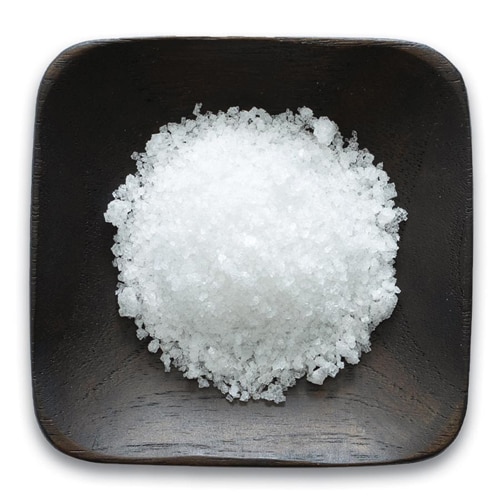Frontier Co-op: Ethically Sourced Spices Available at Vitacost
Frontier Co-Op Fleur de Sel Sea Salt Description
Long considered the caviar of salts, Fleur de Sel (flower of salt) is comprised of slightly moist crystals that look like tiny snowflakes. This rare salt is hand-harvested from pristine salt marshes in Brittany, France, and tastes of the sea. Fleur de Sel has a floral aroma and briny, complex minerality. Pair it with delicate shellfish of any kind. It is the perfect salt for a mixed-from-scratch vinaigrette dressing on tender, fresh greens. Our bulk Fleur de Sel salt is kosher certified and non-irradiated.
Owned by stores and organizations that buy and sell our products, Frontier Co-op® has been a member-owned cooperative since 1976. We support natural living and our products are never irradiated or treated with ETO. We're committed to the health and welfare of the environment and everyone producing and consuming our botanical products.
*These statements have not been evaluated by the Food and Drug Administration. This product is not intended to diagnose, treat, cure, or prevent any disease.
Nutrition Facts
Serving Size: 1/4 tsp (1.2 g)
Servings per Container: 0
| Amount Per Serving | % Daily Value |
|
| Calories | 0 | |
|
| Calories from Fat | 0 | |
|
| Total Fat | 0 g | 0% |
|
| Saturated Fat | 0 g | 0% |
|
| Trans Fat | 0 g | |
|
| Cholesterol | 0 mg | 0% |
|
| Sodium | 530 mg | 22% |
|
| Total Carbohydrate | 0 g | 0% |
|
| Dietary Fiber | 0 g | 0% |
|
| Sugars | 0 g | |
|
| Protein | 0 g | |
|
| Vitamin A | | 0% |
|
| Vitamin C | | 0% |
|
| Calcium | | 0% |
|
| Iron | | 0% |
|
The product you receive may contain additional details or differ from what is shown on this page, or the product may have additional information revealed by partially peeling back the label. We recommend you reference the complete information included with your product before consumption and do not rely solely on the details shown on this page. For more information, please see our
full disclaimer.
Reviews
View printable version
Print Page
Crustless Mini Quiche Cups
[vc_row][vc_column][vc_column_text]Packed with clean, wholesome ingredients, these crustless mini quiche cups are a wonderful way to start your day on the sunny side. Whip them up effortlessly, tossing in fresh basil, broccoli and scallions, along with vegan cheese and almond milk for dairy-free bliss. Whether you're munching them for a grab-and-go breakfast, for dinner with a green salad, or as a high-protein pick-me-up snack, these bitty bites are an egg-cellent choice. Plus, they freeze like champs, ensuring you've always got a healthy, savory treat on hand.

Crustless Mini Quiche Cups

- 6 eggs
- 2/3 cup unsweetened almond milk
- 1-1/4 cups broccoli (chopped or diced)
- 2/3 cup vegan cheese
- 1/4 cup scallions
- 1 handful fresh basil (torn)
- 1/4 tsp. ground white pepper
- Pinch sea salt
Optional
- 1/3 cup green chiles (diced)
- Preheat oven to 350 degrees F. Line about 8 mini muffin pan wells with paper liners.
- In bowl, whisk or beat eggs and incorporate milk, salt and pepper.
- Add broccoli, scallions, basil and cheese and incorporate well. Add chiles here, if using.
- Pour mixture evenly into muffin pan.
- Bake 10-12 minutes, checking at 5-minute mark as some ovens bake more quickly. Make sure toothpick inserted in center comes out clean.
- Garnish with extra cheese and basil.
Add the ingredients to your cart and make these fun quiche cups!

[/vc_column_text][/vc_column][/vc_row][vc_row][vc_column][vc_text_separator title="Featured Products" border_width="2"][vc_row_inner equal_height="yes" content_placement="middle" gap="35"][vc_column_inner width="1/3"][vc_single_image image="174316" img_size="full" alignment="center" onclick="custom_link" img_link_target="_blank" css=".vc_custom_1712958266398{padding-right: 7% !important;padding-left: 7% !important;}" link="https://www.vitacost.com/elmhurst-unsweetened-milked-almonds"][/vc_column_inner][vc_column_inner width="1/3"][vc_single_image image="174317" img_size="full" alignment="center" onclick="custom_link" img_link_target="_blank" css=".vc_custom_1712958293597{padding-right: 7% !important;padding-left: 7% !important;}" link="https://www.vitacost.com/frontier-co-op-organic-ceylon-white-peppercorns"][/vc_column_inner][vc_column_inner width="1/3"][vc_single_image image="174319" img_size="full" alignment="center" onclick="custom_link" img_link_target="_blank" css=".vc_custom_1712958317782{padding-right: 7% !important;padding-left: 7% !important;}" link="https://www.vitacost.com/frontier-co-op-fleur-de-sel-sea-salt"][/vc_column_inner][/vc_row_inner][/vc_column][/vc_row]






